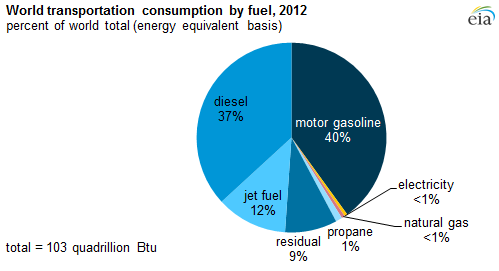Transport Uses 25 Percent of World Energy
The Energy Information Administration has released data showing that the transportation of people and goods accounts for about 25 percent of all energy consumption in the world and that passenger transportation, in particular light-duty vehicles, accounts for most transportation energy consumption. Light-duty vehicles alone consume more than all freight modes of transportation, such as heavy trucks, marine and rail.
The United States was the world's largest transportation energy consumer in 2012, the most recent year with detailed international transportation data by mode. The United States, where on-road passenger travel is especially prevalent, consumed 26 quadrillion British thermal units (Btu) or 13 million barrels of oil equivalent per day (b/d), representing 25 percent of global transportation energy demand in 2012.

Major European countries (those in the OECD) and China are also major transportation energy consumers, at 19 quadrillion Btu and 13 quadrillion Btu, respectively. In contrast to both the United States and OECD Europe, on-road transportation energy use in China more heavily reflects freight movement instead of passenger travel. Together these three regions represent more than 50 percent of world transportation energy consumption.
While on-road use accounts for the largest share of transportation energy in all regions of the world, there is considerable variation across regions in the use of other modes of transportation. For instance, in South Korea marine transport accounts for one-fourth of the country's total transportation energy use, demonstrating the importance of marine transport in this peninsula nation whose economy relies heavily on exports with major trading partners reached by maritime travel.
In Australia and New Zealand, air travel accounts for nearly 20 percent of total transportation energy consumption, compared with 11 percent in the United States and six percent in China. In Australia, regional air travel helps connect coastal population centers and the sparsely populated interior.

Global transportation energy consumption is dominated by two fuels: motor gasoline (including ethanol blends) and diesel (including biodiesel blends). Together, these two fuels accounted for 77 percent of total transportation consumption in 2012. Motor gasoline is used primarily for the movement of people, especially by light-duty vehicles, while diesel fuel is used mostly for the movement of goods, especially by heavy-duty trucks.
Jet fuel accounts for 12 percent of transportation energy consumption, followed by residual fuel oil with 9 percent.
Petroleum products account for the largest share of transportation energy use by far; non-petroleum fuels account for very small portions of the world energy mix, with natural gas and electricity each accounting for about one percent of total transportation energy.

